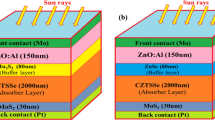Abstract
Copper zinc tin sulphur (CZTS) based solar cells (SCs) became a suitable thin film-based photovoltaic device due to their non-toxic constituents and abundance in nature. The high absorption coefficient with a tunable band gap makes it a suitable material for the next-generation-based SCs. CZTS-based SC models demonstrate higher performance. The overall tuning of CZTS-based SCs to improve efficiency is quite difficult. The overall optimization is addressed by considering both the band gap and thickness of the CZTS layer and buffer layers. This study addresses a novel method of using two materials as buffer layers to enhance cell efficiency. The device performance has been improved based on bi-layer buffer materials proposed in this study. The present study uses a SCAPS-1D SC simulator to numerically investigate CZTS/WS2/In2S3-based SC structures, including ZnO as the window layer and CZTS as the absorber layer. The overall optimization has been considered by taking the contour plots among thickness vs. band gap and bandgap vs. band gap. The device’s efficiency is recorded as 22.96% when the optimum values of the buffer layer are considered. This work reveals a new idea to fabricate a highly efficient SC based on CZTS material for the next-generation photovoltaic device.









Similar content being viewed by others
References
Pal K, Singh P, Bhaduri A and Thapa B 2019 Sol. Eng. Mat. Sol. Cell 196 138
Grossberg M, Krustok J, Hages C J, Bishop D M, Gunawan O et al 2019 Phys. Energy 1 1
Jhuma F A, Shaily M Z and Rashid M J 2019 Mater. Renew. Sustain. Energy 8 1
Burgelman M, Nollet P and Degrave S 2000 Thin Sol. Films 361 527
Kaur K, Kumar N and Kumar M 2017 J. Mater. Chem. A 5 3069
Mahbub R, Saidul Islam M, Anwar F, Sarwar S and Saeed U 2016 South Asian J. Eng. Technol. 2 1
Patel M and Ray A 2012 Phys. B Condens. Matter 407 4391
Xu J, Lin J and Zhuang C 2018 Sol. Energy 164 231
Gupta G K and Dixit A 2018 Opt. Mater. 82 11
Tumbul A, Aslan F, Goktas A and Mutlu I H 2019 J. Alloys Compd. 781 280
Son D H, Kim Y I, Kim S H, Nam D, Cheong H, Kang J K et al 2019 J. Mater. Chem. A. 7 22986
Huang T J, Yin X, Qi G and Gong H 2014 Phys. Status Solidi Rapid Res. Lett. 8 735
Gao S, Jian Z, Wu L, Jianping A, Zeng Y, Sun Y et al 2018 Phys. B 27 1
Chadel M, Chadel A, Bouzaki M M, Aillerie M, Benyoucef B and Charles J P 2017 Mater. Res. Express 4 11
Singh P and Ravindra N M 2012 Sol. Energy Mater. Sol. Cells 101 3645
Li J, Wang H, Luo M, Tang J, Chen C, Liu W et al 2016 Sol. Energy Mater. Sol. Cells 149 242
Sharbati M, Norouzzadeh E and Mohammadi S 2018 Opt. Mater. 78 259
Cherouana A and Labbani R 2017 Appl. Surf. Sci. 424 251
Sadanand and Dwivedi D K 2020 Optik 222 1
Wang W, Winkler M T, Gunawan O, Gokmen T, Teodor K T, Zhu Y et al 2013 AEM Wiley 4 1
Acknowledgements
We would like to thank the Deanship of Scientific Research at Umm Al-Qura University for supporting this work by Grant Code: (22UQU4340560DSR16). We acknowledge VIT AP University for permitting to carry out this work. We are thankful to Dr. Marc Burgelman for providing the SCAPS-1D software freely for the implementation of the models. We extend our appreciation and gratitude to Al-Mustaqbal University College in Iraq for funding this project.
Author information
Authors and Affiliations
Corresponding author
Rights and permissions
About this article
Cite this article
Dakua, P.K., Panda, D.K., Altahan, B.R. et al. Numerical simulation for the high efficient performance signature of TO/ZnO/In2S3/WS2/CZTS based solar cell structure. Bull Mater Sci 46, 78 (2023). https://doi.org/10.1007/s12034-023-02925-3
Received:
Accepted:
Published:
DOI: https://doi.org/10.1007/s12034-023-02925-3




